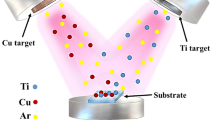Abstract
Introduction
The Cu polyester thin-sputtered layers on textile fabrics show an acceptable bacterial inactivation kinetics using sputtering methods.
Materials and methods
Direct current magnetron sputtering (DCMS) for 40 s of Cu on cotton inactivated Escherichia coli within 30 min under visible light and within 120 min in the dark. For a longer DCMS time of 180 s, the Cu content was 0.294% w/w, but the bacterial inactivation kinetics under light was observed within 30 min, as was the case for the 40-s sputtered sample.
Results and discussion
This observation suggests that Cu ionic species play a key role in the E. coli inactivation and these species were further identified by X-ray photoelectron spectroscopy (XPS). The 40-s sputtered samples present the highest amount of Cu sites held in exposed positions interacting on the cotton with E. coli. Cu DC magnetron sputtering leads to thin metallic semi-transparent gray–brown Cu coating composed by Cu nanoparticulate in the nanometer range as found by electron microscopy (EM). Cu cotton fabrics were also functionalized by bipolar asymmetric DCMSP.
Conclusion
Sputtering by DCMS and DCMSP for longer times lead to darker and more compact Cu films as detected by diffuse reflectance spectroscopy and EM. Cu is deposited on the polyester in the form of Cu2O and CuO as quantified by XPS. The redox interfacial reactions during bacterial inactivation involve changes in the Cu oxidation states and in the oxidation intermediates and were followed by XPS. High-power impulse magnetron sputtering (HIPIMS)-sputtered films show a low rugosity indicating that the texture of the Cu nanoparticulate films were smooth. The values of R q and R a were similar before and after the E. coli inactivation providing evidence for the stability of the HIPIMS-deposited Cu films. The Cu loading percentage required in the Cu films sputtered by HIPIMS to inactivate E. coli was about three times lower compared to DCMS films. This indicates a substantial Cu metal savings within the preparation of antibacterial films.






Similar content being viewed by others
References
Borkow G, Gabbay J (2008) Biocidal textiles can help fight nosocomial infections. Med Hypothesis 70:990–994
Castro C, Sanjines R, Pulgarin C, Osorio P, Giraldo SA, Kiwi J (2010) Structure-reactivity relations of the Cu-cotton sputtered layers during E. coli inactivation in the dark and under light. J Photochem Photobiol A 216:295–302
Dhananjeyan MA, Mielczarski E, Thampi K, Buffat Ph, Bensimon M, Kulik A, Mielczarski J, Kiwi J (2001) Photodynamics and surface characterization of immobilized TiO2 and Fe2O3 photocatalysts on modified polyethylene films. J Phys Chem B 105:12046–12055
Dunlop MSP, Sheeran CP, Byrne AJ, McMahon SAM, Boyle MA, McGuigan KA (2010) Inactivation of clinically relevant pathogens by photocatalytic coatings. J Photochem Photobiol A 216:303–310
Ehiasarian P, Vetushka A, Hecimovic A, Konstantinidis S (2008) Ion-composition produced by high power impulse magnetron sputtering discharges near the substrate. J Appl Phys 104:083305
Foster AH, Sheel WD, Sheel P, Evans P, Varghese S, Rutschke N, Yates MH (2010) Antimicrobial activity of titania/silver and titania/copper films prepared by CVD. J Photochem Photobiol A 216:283–289
Gabbay G, Borkow J, Mishal E, Magen E, Zatcoff E, Shemer-Avni Y (2006) Copper impregnated products with potential biocidal activities. Ind Text 35:223–228
Gedanken A (2004) Using sonochemistry for the fabrication of nanomaterials. Ultrason Sonochem 11:47–53
Kramer A, Schwebke I, Kampf GA, Kramer I, Schwebke G (2006) How long do socomial pathogens persist in on inanimate surfaces? BMC Infect Dis 6:130–136
Kusiak-Nejman E, Morawski WA, Ehiasarian PA, Pulgarin C, Mielczarski E, Mielczarski J, Kulik A, Kiwi J (2011) E. coli inactivation by high power impulse magnetron sputtered (HIPIMS) cu-surfaces. J Phys Chem C 115:21113–21119
Lin J, Moore J, Sproul W, Mishra B, Wu Z, Wang E (2010) The structure and properties of chromium nitride coatings using dc, pulsed dc and modulated pulse power magnetron sputtering. Surf CoatTechnol 204:2230–2239
Mathews JW (ed) (1975) Epitaxial growth, part B, Ch 4: nucleation of thin Films. Academic, New York, pp 382–486
Mejía MI, Restrepo G, Marín MJ, Sanjines R, Pulgarín C, Mielczarski E, Mielczarski J, Kiwi J (2010) Magnetron-sputtered Ag-modified cotton textiles active in the inactivation of airborne bacteria. ACS Appl Mater Interf 2:230–235
Osorio P, Sanjines R, Ruales R, Castro C, Pulgarin C, Rengifo J-A, Lavanchy J-C, Kiwi J (2011) Antimicrobial Cu-functionalized surfaces prepared by bipolar asymmetric DC-pulsed magnetron sputtering (PMS). J Photochem Photobiol A 220:70–76
Page K, Wilson M, Parkin PI (2000) Highly bioactive silver and silver/titania composite films grown by chemical vapor deposition. J Mater Chem 19:3819–3831, and references therein
Perelshtein I, Applerot G, Perkas N, Wehrschuetz-Sigl E, Hasmann A, Guebitz G, Gedanken A (2009) CuO-cotton nanocomposite: formation, morphology and antibacterial activity. A Surf Coat Technol 204:54–57
Sarakinos K, Alami J, Konstantinidis S (2010) High power pulsed magnetron sputtering: a review on scientific and engineering state of the art. Surf CoatTechnol 204:1661–1684
Shirley DA (1975) Sensitivity factors in the determination of elements by X-ray photoelectron spectroscopy. Phys Rev B5:4709–4716
Torres A, Ruales C, Pulgarin C, Aimable A, Bowen P, Sarria V, Kiwi J (2010) Enhanced inactivation of E. coli by RF-plasma pretreated cotton/CuO (65 m2/g) under visible light. JACS Appl Mater Interf 2:2547–2552
Wagner DC, Riggs WM, Davis LE, Mullenberg GE (eds) (1979) Handbook of X-ray photoelectron spectroscopy. Perkin-Elmer Corp. Physical Electronics Division, Minnesota
Yuranova TA, Rincon GA, Pulgarin C, Laub N, Xanthopoulos N, Mathieu J-H, Kiwi J (2006) Performance and characterization of Ag-cotton and Ag/TiO2 loaded textiles during E. coli abatement. J Photochem Photobiol A 181:363–369
Acknowledgments
We wish to thank the COST Action MP0804 Highly Ionized Pulse Plasma Processes (HIPIMS), the EPFL, and the Swiss–Hungarian Cooperation Program “Sustainable fine chemical pharmaceutical industry: screening and utilization of liquid wastes” for the support of this work.
Author information
Authors and Affiliations
Corresponding authors
Additional information
Responsible editor: Philippe Garrigues
Rights and permissions
About this article
Cite this article
Ehiasarian, A., Pulgarin, C. & Kiwi, J. Inactivation of bacteria under visible light and in the dark by Cu films. Advantages of Cu-HIPIMS-sputtered films. Environ Sci Pollut Res 19, 3791–3797 (2012). https://doi.org/10.1007/s11356-011-0734-7
Received:
Accepted:
Published:
Issue Date:
DOI: https://doi.org/10.1007/s11356-011-0734-7




